Deer Reaction Time and Jumping the String
Diving Into the Data Around a Deer’s Reaction Time and How they Jump the String
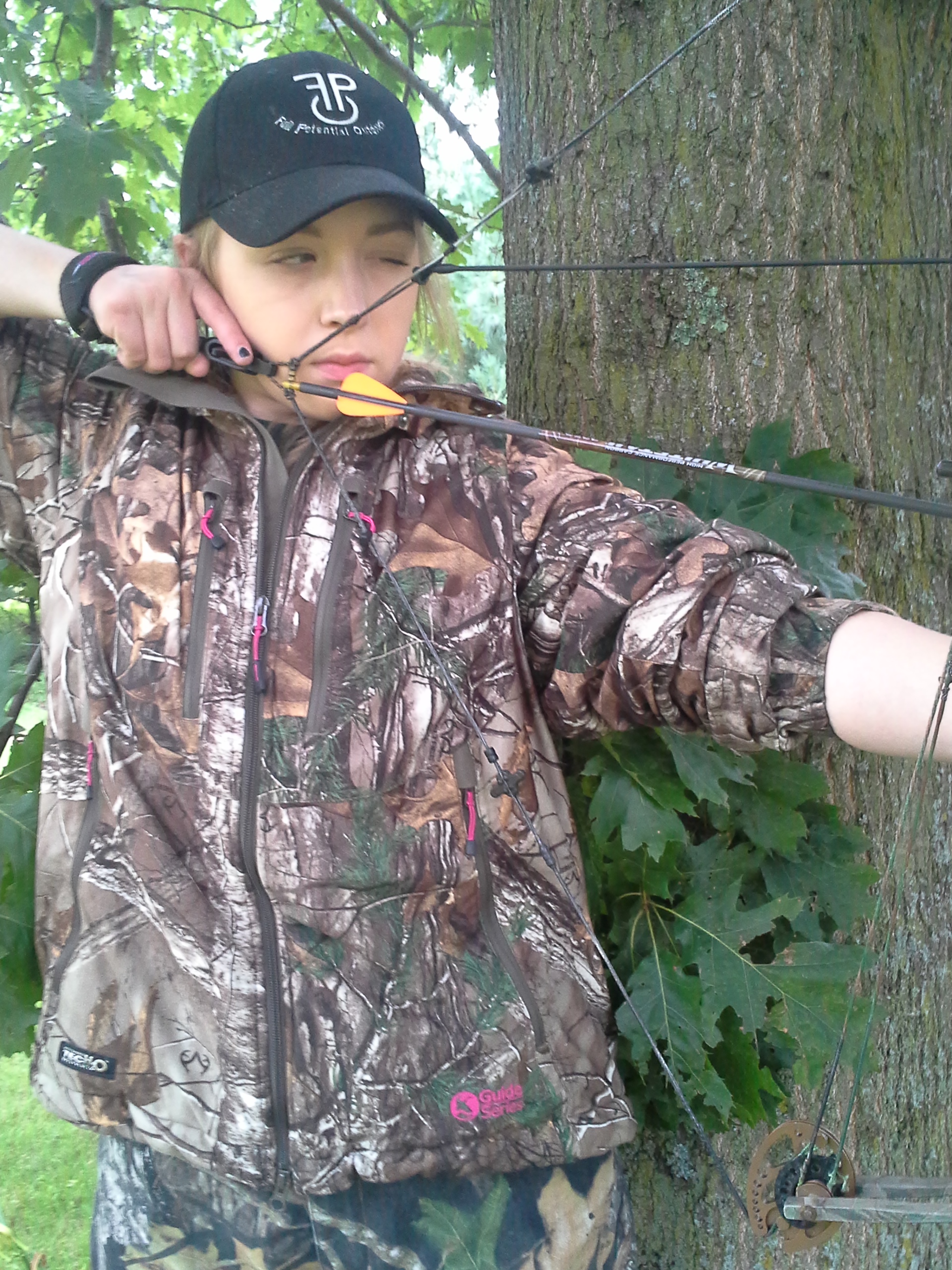
Picking the right spot to aim is the most important thing you can’t get wrong at the moment of truth.
If you’ve never been there, you’re lucky! But most archery hunters have experienced that deep guttural feeling when you release an arrow only to see it drive into a deer way off mark. That sick feeling knowing you didn’t make a good shot. Will you find the deer? Will it make it and recover? Re-living the moment over and over in your head asking what you could’ve done different…what went wrong?
There was a time when my field shooting at deer was far less than perfect. I always considered myself a good or decent shot but once in the field it seemed like my arrows were more like curve balls. I couldn’t understand the discrepancy? Writing it off as buck fever my solution was to merely practice more. This really solved nothing for me. Once I understood what was happening, and made adjustments simply to where I was aiming, everything changed!
The Science of Arrow Flight
When an arrow leaves your bow parallel to the earth, two forces act on it. Friction causes the arrow to slow down and gravity pulls the arrow down toward the earth. Gravity pulls on the arrow downward with the same force no matter the speed of the arrow…but the faster it goes the farther down field it can fly in relationship to how far it falls. This is why a super-fast arrow flying at 350 feet per second (fps) will only drops about a foot at 30 yards while a slower bow at 280fps may drop 20 inches or more; and why an arrow will drop more for each yard it travels down range…because it is moving slower and slower due to friction. To show my point more dramatically, that same 350fps arrow drops about 24 inches at 40 yards, while the 280fps arrow can drop as much as 40 inches; almost double.
To compensate for the forces of gravity and friction, we site our bows in to correct for this arc. The faster the arrow, the flatter the arc and less compensation is needed. Less compensation means making distance estimating in the field less crucial. Using multiple site pins and range finders can help archers to be more accurate; but do they really help all that much in the field under hunting conditions? I prefer a single pin (for reasons to come) and use my range finder only at the beginning of the hunt to verify distances.
The Science of Deer Movement
About 5 years ago, I started taking an informal survey of all the people I knew (and trusted to tell the truth) that missed or put poor hits on deer. In almost all cases the poor or missed shots were high—unless the hunter admitted to taking a poor shot or the arrow was deflected.
When a deer reacts to immediate danger, their first response is almost always flight. When they go to run, the first thing they do is load their leg muscles resulting in them dropping as much as a foot or more. This allows them to bolt with amazing speed. I studied dozens of filmed bucks and does being shot at on video over the last 12 years. In each case, I was able to watch frame by frame as the arrow left the bow and traveled to the deer. In over 80% of cases the deer dropped or started to drop in preparation for flight. About 20% of the time the deer made no reaction at all or the deer were close enough that their reaction time wasn’t fast enough to have an impact. Each case was very similar to the next. It took an average of about .16 seconds from arrow release for a deer to start moving or loading, and .28 seconds for a deer to fully load their legs or complete the downward movement. In as little as only .36 seconds from the time you fire your arrow, a deer can load-drop-then unload springing forward or twisting and turning making your shot land off mark. Bucks and does move at same average speeds. Deer that were calm showed just as much movement as those that were alert although calm deer reacted slightly less of the time than alert deer.
Arrow Flight Part II-Aiming
When you aim at a deer and can visualize your arrow going right into the center of the vitals, and then release, a whole bunch of stuff happens. The sound of your bow going off reaches the deer’s ears very fast. With each yard your arrow flies the deer has time to react in preparation to run which causes them to drop more and more. If the deer is far enough away, they can actually begin releasing the stored energy in their legs bolting and twisting as they take their first stride. This dropping is causing high hits! I would assert more deer each year are missed or wounded because of this deer caused high hit than all the other reasons combined. Aiming for the center of the vitals is the wrong place to aim!
I want to be clear about something here…deer are not “ducking” your arrow, or trying to “dodge” the arrow. They are simply reacting to the sound your bow makes. Last year, in preparation for this article, I filmed several deer that reacted the same way to a cough and several to a clap. They do not know they are being shot at, they are only reacting to a stimulus (in this case a rather loud noise they are not familiar with) and are preparing to run.
By aiming low in a deer’s vitals, you remove the chance of those high hits. I aim for the heart and have been for quite some time. This allows me to aim small and pick a spot while preventing a deer from jumping the string and dropping so far that my arrow misses or hits high. Because I know I have an arc, I site my bow in with one pin at a point in my trajectory that I’m only slightly high at closer ranges and only somewhat low farther out. This allows me to aim low heart—heart—and high heart in my effective range with a single pin. The slower arrow you shoot the shorter your effective range is regardless of whether you have another 2 or 3 pins to compensate. Why? Because once you’ve reached that point where you need a second or third pin and must compensate that much, you are way out beyond the distance where a deer will simply drop. Now you are out in the range where a deer can drop, bolt, twist, and turn before your arrow ever gets there. Being accurate on the range is simply not the same as being consistent in the field. By taking only shots within your effective range, and aiming low by picking a heart shot, you will greatly increase the likelihood of making good shots and avoiding those high hits.
All too often, in the moment of truth, hunters who have taken and practice this advice have still aimed in the center of the vitals when in the moment of truth. Why? Because of the fear of missing the deer low…shooting under. I can only tell you that with practice and confidence at making those heart shots, you will simply put the vast majority of your arrows in the heart or center vitals when they drop and avoid those high hits and misses…as well as those sleepless gut wrenching nights thinking about a poor hit.
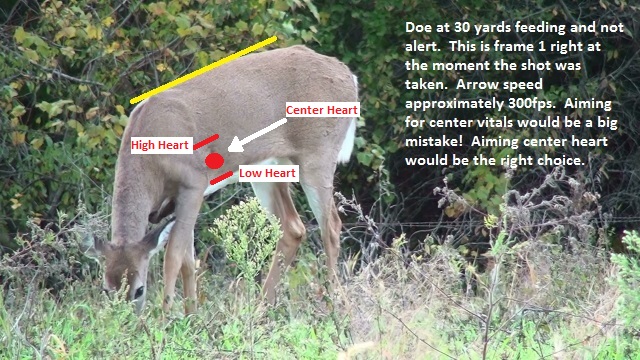
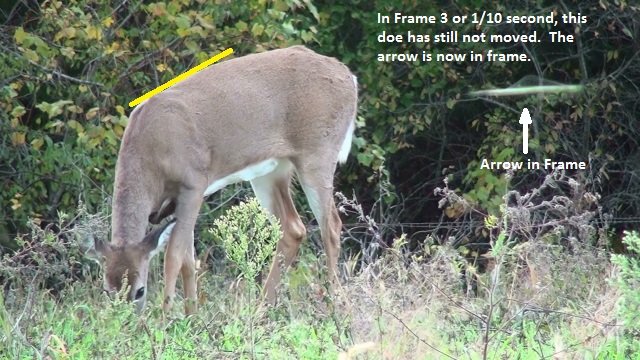
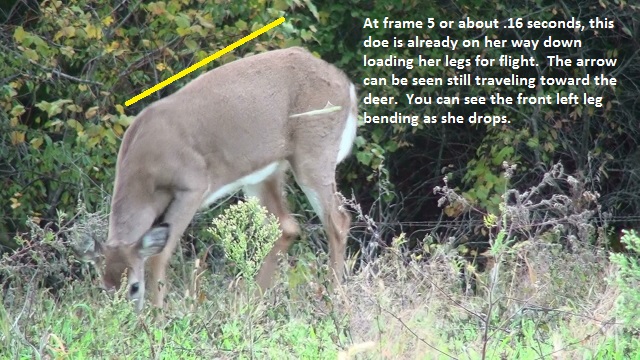
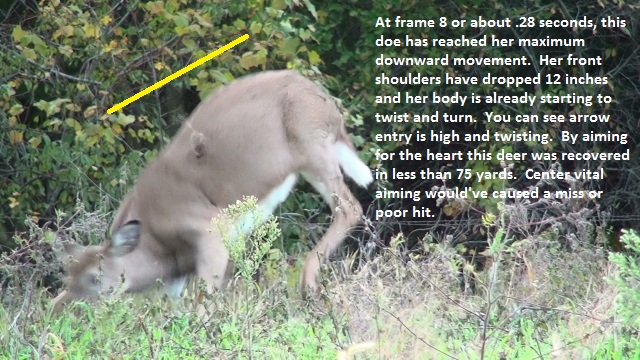
| Arrow Speed | Yards Before | Yards Before | Effective | |||
| In Feet/Sec. | Initial Movement | Max Movement | Range | |||
| 180 | 9.6 | 16.8 | 21.6 | |||
| 200 | 10.7 | 18.7 | 24 | |||
| 220 | 11.7 | 20.5 | 26.4 | |||
| 240 | 12.8 | 22.4 | 28.8 | |||
| 260 | 13.9 | 24.3 | 31.2 | |||
| 280 | 14.9 | 26.1 | 33.6 | |||
| 300 | 16 | 28 | 36 | |||
| 320 | 17.1 | 29.9 | 38.4 | |||
| 340 | 18.1 | 31.7 | 40.8 | |||
| 360 | 19.2 | 33.6 | 43.2 | |||
| 380 | 20.3 | 35.5 | 45.6 |
Yards Before Initial Movement-This is the distance at your arrow speed that a deer will begin loading their legs and dropping. Before this distance, your arrow will arrive before a deer can react.
Yards Before Max Movement-At your arrow speed, this is the distance a deer will reach maximum downward movement.
Effective Range-The distance at which a deer can load-unload-and begin its flight. For your arrow speed, you should not attempt shots in the field at distances greater than this.
